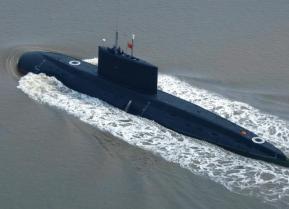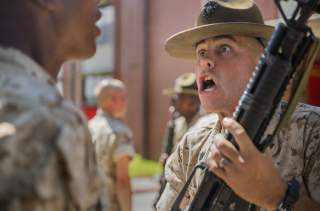In the Very Near Future, 12 Marines Will Be Deadlier Than 13. This Is Why.
When are 12 Marines more lethal than 13? That math is the equation informing the recently reconfigured Marine Rifle Squad. Said to arrive in FY 2020, the new formation will be smaller, shrinking from 13 positions to 12. Yet these newly-configured squads will add a suite of new technology
The Commandant of the Marine Corps plans to reduce the configuration of Marine Rifle Squads from 13 down to 12 by increasing firepower and adding drone technology.
When are 12 Marines more lethal than 13? That math is the equation informing the recently reconfigured Marine Rifle Squad.
Said to arrive in FY 2020, the new formation will be smaller, shrinking from 13 positions to 12. Yet these newly-configured squads will add a suite of new technology, including tablets and drones, and a significant increase in firepower, including a fully automatic rifle for each of the 12 squad members -- up from the three automatic rifles assigned per squad currently. The result? Increased firepower, because now all 12 Marines in the Rifle Squad will be equipped with automatic weapons.
The sum of these changes equals a squad ever "more lethal, agile, and capable" according to Marine Commandant Robert Neller in video posted to Twitter.
Currently, a Marine Infantry Rifle Squad is run by one squad leader who guides three fire teams of four members each, for a total of 13 positions. The breakdown of the current configuration is that each of these three fire teams at present is led by a fire team leader, who guides one automatic rifleman, one assistant automatic rifleman, and one rifleman.
The decision to change this standard Marine Rifle Squad configuration follows a re-evaluation sparked by two modernization initiatives, Marine Corps Vision and Strategy 2025 Marine Corps Vision and Strategy 2025 and Sea Dragon 2025, the active experiment program which, according to a Marine statement, is dedicated to “assess changes to the infantry battalion mandated by Marine Corps Force 2025.” Sea Dragon 2025 HERE
“To be clear,” explained Neller, “the mission of the Marine Rifle Squad remains unchanged: to locate close with and destroy the enemy by means of fire, maneuver, and close combat."
The new arithmetic works like this: there will still be three fire teams in each rifle squad, but each of those three fire teams will lose one position, and going forward each fire team will have only have three members each, no longer four. So, what the are other positions that will bring the new Marine Rifle Squad up to 12?
The answer: changes at the top.
Recommended: Forget the F-35: The Tempest Could Be the Future
Recommended: Why No Commander Wants to Take On a Spike Missile
Recommended: What Will the Sixth-Generation Jet Fighter Look Like?
As noted above, instead of a squad leader directing three teams of four, we will soon see a squad leader leading three teams of three. Yet, this Rifle Squad Team Leader position will itself now get significant dedicated support from two other newly-established positions assigned to support the Squad Team Leader --and the mission-- in the field: an assistant squad leader, a corporal, who, according to the Marines, assists with "increasingly complex squad operations." The other new position is a lance corporal who serves as “squad systems operator” integrating and operating new technology, according to a statement from the Marines.
The new Marine Rifle Squad Leader, a sergeant, charged with carrying out the platoon commander's orders, is now expected to have "five to seven years of experience” and will be given "formal training as a squad leader,” according to a statement from Marine Captain Ryan Alvis.
The lighter footprint of this new 12-position formation reflects an approach long-articulated in training materials -- "the Marine Corps philosophy of war fighting is based on an approach to war called maneuver warfare." This legendary maneuverability continues to inform the focus of Neller's recent changes and explains why the Marine Corps is changing up the math of its long-established Marine Rifle Squad formation.
This "reorganization of the infantry will occur over the next three to five years, although some of the changes are happening now" according to Captain Alvis. This means that in addition to one fewer marine, the changes also bring newer tech. The positions are changing, but so are the assigned equipment and weaponry.
Now each member of the Rifle Squad will be assigned an M320 automatic rifle, designed and built by Heckler & Koch, a German company founded in 1949. The M320s will replace the M4 carbine semi-automatic, a legacy weapon developed by the American manufacturer Colt. Heckler & Koch also developed and manufactures the M320 grenade launchers that the Marines have determined will be used by each of the three dedicated grenadiers assigned to each newly configured fire team.
Other hardware to be assigned includes a MAAWS, Multi-Role Anti-Armor Anti-Personnel Weapon System, known as the Carl Gustaf. This anti-tank rifle is described by its manufacturer, the Sweden-based Saab corporation, as "light and ruggedized and its multi-purpose capability provides freedom of action. . . in all environments." The Carl Gustaf has in the past been hailed for its accuracy and portability by tech and design outlet Gizmodo, because the weapon "looks like a Bazooka but shoots like a rifle."
Each of the new 12-spot rifle squad formations will also get one M38 Designated Marksmanship Rifle. At a range of 600 meters, the M38, a Heckler & Koch product, has, in the past, been criticized as not being comparable to the world’s best sniper rifles. Yet it should work well, according to the Marines, as a marksman rifle. The M38, a Marine statement notes, is equipped with a suppressor and also a variable 2.5-8 power optic. Although not intended for sniper use, a Marine statement explains that the “individual employing this weapon (will receive) additional training on range estimation, scope theory, and observation.”
Battles of the future will not be won by firepower alone. General Neller has long been quoted as saying that each infantry squad would one day be assigned its own small unmanned aerial device. That day is coming. A Marine statement confirmed that “each squad will have a . . . quadcopter to increase situational awareness of the squad leaders.”
Another addition to the field? The PRC-117G Radio will be lighter, more portable than the current radio equipment, and will provide more than audio. Encrypted visuals allow "warfighters to communicate beyond the lines of sight," according to its manufacturer, the Harris Corporation, a publicly traded U.S company that specializes in communications, electronics, and space and intelligence systems.
Also in the mix: a Marine Corps Common Handheld Tablet. As General Neller explains, the mix of technology and weaponry allows the USMC “to move forward and get ready for the next fight. Wherever it is.” A Marine Corps statement notes that the infantry would remain a key focus of Marine Corps strategy because “superior infantry is a Marine Corps asymmetrical advantage.” The statement also quotes Gen. Neller as saying “The surest way to prevent war is to be prepared to dominate one.”
This first appeared in Warrior Maven here.


